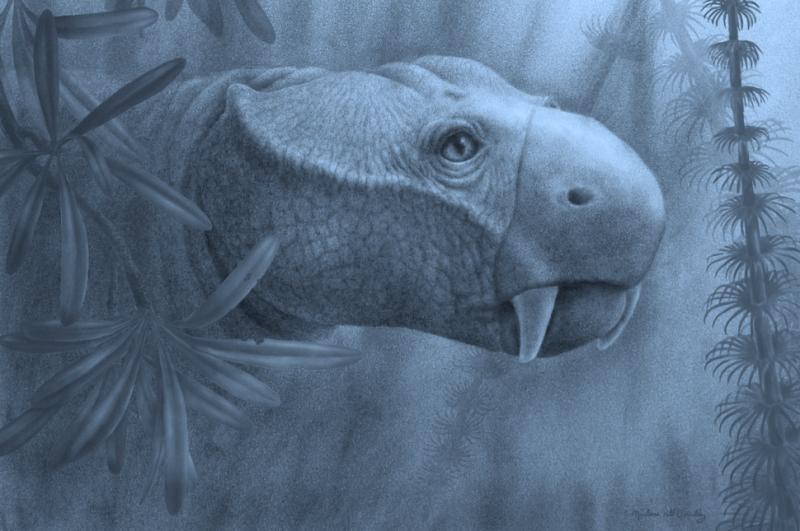As growing numbers of species in the modern world face extinction because of global climate change, habitat destruction, and over-exploitation, scientists have turned to the fossil record to understand how mass extinctions in the past proceeded, and how species and ecosystems recovered in the aftermath of such events.
Much work so far suggests that the survivors of mass extinctions often are presented with new ecological opportunities because the loss of many species in their communities allows them to evolve new lifestyles and new anatomical features as they fill the roles vacated by the victims.

Reconstruction of the Permian anomodont Dicynodon lacerticeps. (Credit: Marlene Donnelly, Field Museum of Natural History)
However, it turns out that not all survivors respond in the same way, and some may not be able to exploit fully the new opportunities arising after a mass extinction. A team of researchers from the University of Lincoln, the Field Museum of Natural History in Chicago, the Museum für Naturkunde in Berlin, and the University of Bristol examined how a group of ancient relatives of mammals called anomodonts responded in the aftermath of the largest mass extinction in Earth history. Their work, published this week in Proceedings of the Royal Society B and titled “Decoupling of morphological disparity and taxic diversity during the adaptive radiation of anomodont therapsids,” shows that anomodonts remained anatomically conservative even as the number of species rebounded during the recovery.
The mass extinction at the end of the Permian Period, about 252 million years ago, had profound effects on organisms on land and in the sea, with as many as 90% of marine organisms and 70% of terrestrial species becoming extinct. “Groups of organisms that survive such a mass extinction are said to have passed through an evolutionary bottleneck analogous to the genetic bottleneck that may occur in a population if many of its members die off,” said Dr. Marcello Ruta of the University of Lincoln, the lead author of the study. “At the population level, a genetic bottleneck sometimes allows the population to move to a new evolutionary trajectory, but other times it constrains the future evolution of the population.”
“Near the end of the Permian, a large number of anomodont species existed that displayed a wide range of body sizes and ecological adaptations, including terrestrial plant eaters, amphibious hippo-like species, specialized burrowers, and even tree-dwelling forms,” said Dr. Kenneth Angielczyk. “The most successful group of anomodonts had canine-like tusks in their upper jaws and turtle-like beaks, and they were the most important terrestrial herbivores of their time.”
“The number of anomodont species increased during the Permian, sharply dropped during the end-Permian extinction event, and then rebounded in the Middle Triassic Period (about 240 million years ago) before the final extinction of the group at the end of the Triassic,” said Professor Jörg Fröbisch. “However, the variety of different anatomical features found in anomodonts, i.e. their anatomical diversity (also known as morphological disparity), declined steadily over their history. Even in the aftermath of the mass extinction, when there should have been a lot of empty ecological space, anomodonts did not evolve any fundamentally new features.” “This suggests that the evolutionary bottleneck they passed through during the extinction constrained their evolution during the recovery,” added Dr. Ruta.
Analyzing the response of animals and plants to this catastrophe helps us understand models of diversification and patterns of ecosystem reconstruction following large-scale biological crises. “This is the first study of its kind to address simultaneously changes in species number and anatomical diversity in anomodonts, and to quantify their response to the most catastrophic extinction on record. Anomodonts are abundant, diverse, and well studied, which makes them ideal models for evolutionary analyses,” said Professor Michael Benton. “The results underscore that recoveries from mass extinctions can be unpredictable, a finding that has important implications for the species extinctions being caused by human activity in the world today. We cannot just assume that life will return to the way it was before the disturbances.”



 August 19th, 2013
August 19th, 2013  Riffin
Riffin  Posted in
Posted in  Tags:
Tags: 